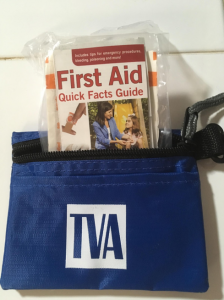Please note: comments to the NRC are due July 13, 2018 – you can take action here.
Honestly, my knowledge surrounding nuclear power was somewhat limited. In my Master’s program, I gained knowledge about policy issues surrounding nuclear waste storage at Yucca Mountain, a proposed federal repository; I watched, horrified, at news reports about the Fukushima meltdown in Japan; I saw documentaries on the Chernobyl accident in the former Soviet Union; and a peer’s presentation in college was the first I had heard about small modular reactors (SMRs).
Because my expertise is in other energy areas, I was hesitant to attend the June hearing on the Nuclear Regulatory Commission’s (NRC) Draft Environmental Impact Statement (DEIS) for an early site permit (ESP) for SMRs at TVA’s Clinch River Nuclear Site. I was not sure I could clearly state why TVA should abandon its plan to invest in this new nuclear project. However, after reading through the DEIS, I realized there were clearly some alarming safety issues. Then I found my personal motivation: I realized my family would be at risk. My son’s home when they are with their father was within the ten-mile emergency evacuation zone, standard to other nuclear projects, which TVA has proposed to reduce to two miles or the site boundary for the Clinch River SMR project. At first, I was alarmed my two sons would be in harm’s way, but was even more alarmed the emergency planning zone would not even include my former spouse and sons in the planning process if there were a nuclear accident. I had the realization there were even a larger number of communities, families, businesses, infrastructure, and environmental areas that might be at risk if I did not take action.
 Reading the DEIS for the Clinch River SMR site made me think about a funny saying my friends and I used to use: “Safety Third.” Why safety third? The answer is priorities. Our phrase was insinuating to put fun first under any circumstance when with friends, but I realized TVA was putting safety lower on the list of priorities by pursuing an experimental technology combined with the proposal to reduce the industry-standard 10-mile emergency planning zone.
Reading the DEIS for the Clinch River SMR site made me think about a funny saying my friends and I used to use: “Safety Third.” Why safety third? The answer is priorities. Our phrase was insinuating to put fun first under any circumstance when with friends, but I realized TVA was putting safety lower on the list of priorities by pursuing an experimental technology combined with the proposal to reduce the industry-standard 10-mile emergency planning zone.
At the NRC meeting, TVA provided the public with free TVA swag: wallet-sized first aid kits. However, TVA providing this “nuclear first aid kit” was not as comforting as actually ensuring safety as a top priority to innovation and economic development. Why reduce the emergency planning zone, TVA? Safety should come first, not third, in terms of any nuclear power project.
A motivation behind reducing the emergency planning zone is actually related to cost. If the emergency planning zone is reduced, there are less communities, homes, businesses, infrastructure, and environmental areas to evaluate and coordinate with inside the smaller radius. Proponents claim SMRs are an attractive nuclear technology because they could be cheaper to produce and have the potential to become an export to countries and utilities that cannot afford large nuclear projects, which raises nuclear proliferation concerns. However, the costs are partly reduced at the expense of numerous safety measures such as reducing staff onsite, including security staff, altering the design of spent fuel pools, which increases fire-risk, and reducing the emergency planning zone. SACE and the Tennessee Environmental Council (TEC) legally intervened in June 2017 and more recently highlighted such concerns in newly filed contentions based on the DEIS.
To date, no SMR designs have been certified by the NRC, and the affordable cost claim has not materialized; SMRs are estimated to be extremely expensive. For the safety of my family and the nearby community, my expectation would be to see the 10-mile emergency planning zone remain in place.
TVA’s SMR proposal fails for another reason related to cost: the flat and declining load growth for energy. TVA does not need new supply and certainly does not need the most expensive supply option. TVA’s Strategic Plan stated the need for not only rate increases, but a rate change, and a debt reduction plan to help manage the reduced demand for energy resulting from energy efficiency and renewable investments. Much of TVA’s current debt was a result of abandoned nuclear projects, including the breeder reactor at the Clinch River site, and nuclear projects like Watts Bar 2 that took nearly forty years to finish and went billions over budget. With TVA’s poor track record bringing nuclear projects in on time and budget, an experiment like the Clinch River SMR proposal will likely go against TVA’s plans to reduce its debt.

I was proud to stand with concerned residents, experts, and my SACE colleague, Sara Barczak, who also delivered comments, in telling the NRC to choose the “no action alternative.” It’s not too late to tell the NRC you oppose TVA’s Clinch River SMR project and “safety third” assessment.
The NRC is taking public comments until July 13, 2018. You can voice your opinion to the NRC here.


